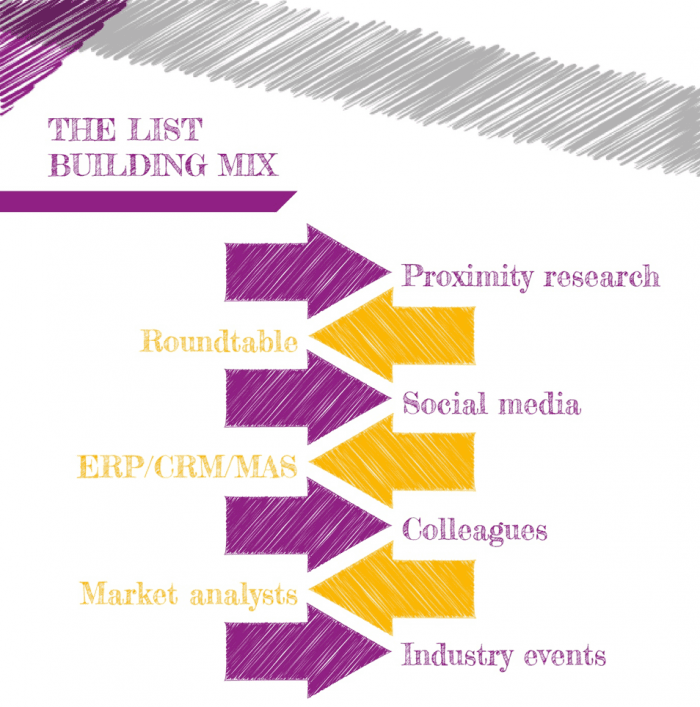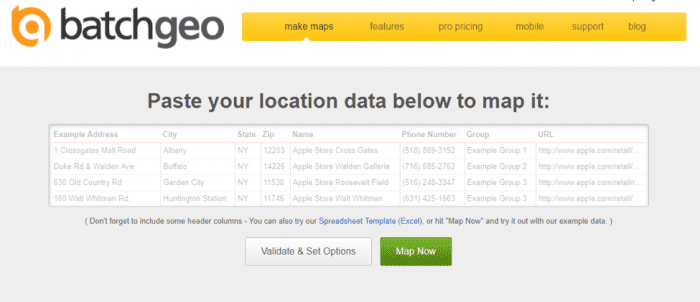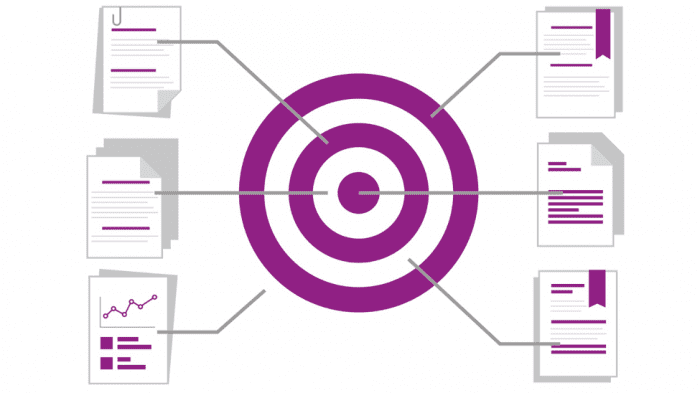Practical AMB guidance for putting together your account-based marketing target list to get results, fast
Account-based marketing starts with a clear picture of who to target. Sounds simple enough. But with account-based marketing (ABM) being such a new thing for so many marketers, building the right focus list is often not as easy as it first sounds.
I’ve found with so many clients, they end up getting steamrolled by the ‘Who should we target’ question.
When you keep hearing the same query time after time, you realize there’s clearly an education piece that’s needed. So here we are!
It’s worth pointing out at this stage that this guidance is based on best practices gathered from being involved in a number of account-based marketing deployments. There are no hard and fast rules to any of this, so feel free to tweak depending on the individual circumstances of your business. Anyway, now we’ve got that out of the way, let’s begin.
Choosing the right account-based marketing list building tactic
Account-based marketing is fundamentally a marketing approach that’s based on commercial results. Sales and marketing align to the same KPIs, meaning all that matters is the number of accounts you’ve onboarded and the amount of revenue that’s been achieved. With that in mind, you should target the accounts that you have the greatest chance of converting.

Looking for marketing strategy and planning advice?
Obviously, you've come to this page for ABM tactics. That's why the rest of this article is dedicated to the specific channels that do and don't work for bringing in more accounts from your list. But don't forget ABM is just one aspect of a strong omnichannel marketing strategy.
If you're interested in learning more about planning and managing digital marketing, why not book a free 1-2-1 consultation? Our consultation calls are designed to put you in the driving seat when discussing your company's opportunities and challenges in the digital world.
Our integrated marketing structure, the RACE Framework, expands beyond single-channel tactics to help you build a marketing funnel that is efficient and effective across the omnichannel customer journey. Find out more Need a winning marketing strategy?
Book your free 1-2-1 consultation to develop your new strategy with the RACE Framework
Book consultation
Proximity research
Proximity can be an interesting element to consider. When you think in terms of proximity, it can open up tactical opportunities:
- Proximity to existing customers
- Proximity to engineering depots/resource
- Proximity to HQ
These are just some of the methods we’ve seen executed, there are probably loads more you’re thinking of right now. Proximity research in years gone by was a painstaking task - that is before technology gave us the answer (thanks again our silicon saviour).
If your business is lucky enough to have a data warehouse that runs a visualization/BI platform - you get to pass go and collect £200. For the rest of us, there’s a nifty tool called BatchGeo. This tool’s been around for what seems an eternity. It rocks a pretty simple UI - but the insight it gives you is just what the doctor ordered.
Here’s a step-by-step guide to using BatchGeo to create an account-based marketing list using proximity to existing customers:
- Step 1: Export a CSV spreadsheet from your CRM/ERP system that includes existing customers and prospects. Tip: Try and match the export formatting to as closely match the ordering and structure found in the BatchGeo template file (this will save you some admin on the next step).
- Step 2: Get the data in the right structure for BatchGeo (see - wasn’t that easier as a result of spending an extra 2 minutes on the export formatting?).
- Step 3: In one of the ‘Group’ columns, ensure that each row has either Prospect or Customer inputted into the respective field.
- Step 4: Copy and paste the data into BatchGeo, click ‘Map Now’ and then generate.

- Step 5: Hey presto! You now have a bespoke Google Map with different coloured markers for your customers and prospects. You can play around with the various formatting options to get the desired look and feel. The process above is obviously easily tweaked to undertake any of the other types of proximity research discussed above. This makes proximity analysis for your accounts a much less admin intensive experience and navigating across your territories a much more pleasing experience.
Download Free Member resource – Digital Marketing Optimization
This report will allow you to benchmark your organization's optimization efforts against other senior marketers based on a survey of Smart Insights members and Technology for Marketing attendees.
Access the
Account-based marketing roundtable approach
Having the right ABM team from the outset is critical. Who should be part of your ABM dream team? Here are the key roles to consider when you’re building a collection of bodies:
Project Lead
This is the person who is ultimately responsible for bringing it all together. They’re usually a marketing leader.
They need to be someone who has the passion and drive to make things happen, is able to inspire and influence colleagues behind the ABM movement, and is a strong enough character to overcome challenges, objections and general adversity.
Project manager (PM)
The nitty-gritty co-ordinator. The PM holds the project, and the people involved, to account. They make sure that targets are met, timings are rigid and the project stays on track. This needs to be a detail-oriented person who is a proven project manager and obsessed about seeing things through to a positive conclusion.
Executive Marketing Sponsor
For an ABM project to get away, and sustainably make it to the point where it’s contributing the huge returns that are possible, it’s 100% critical to ensure that support is fostered at the most senior level. A senior marketing sponsor is a must. C-Suite/board level - this is where it needs to be. Settle for less at the project’s peril!
Executive Sales Sponsor
Clearly, ABM is all about marketing. But it’s one of the few marketing approaches that see a true shared value (and as such shared responsibility) between sales and marketing. So if sales are going to be benefitting from it (and also accountable) then they also need representation from the C-Suite.
Usually, this is a pretty easy sell. Nothing gets a senior sales leader excited more than the temptation of snaring huge strategic prospect wins and this is often a primary aim of executing an ABM campaign. Once you have them involved, they’ll be able to ask great questions of the group to stimulate some thinking.
They also - by the nature of their role - understand where the big deals in the market could be done in the foreseeable future. Important stuff right?
Marketing representative(s)
A driving force behind activating on ABM is the marketing campaign that moves people through the funnel. Whether an amended traditional funnel or using the ‘land and expand’ methodology, marketing is the key driver of this forward momentum towards KPI heaven.
How many reps you have involved largely depends on the size of the business and the size of the budget. If it’s a big ABM campaign, you’ll have more people involved in activation.
I think a good rule of thumb here is if you suspect a marketing person or team is going to be central to delivering on that momentum, they need to be involved in a roundtable exercise.
Don’t forget, Marketing is the frontline in lead generation. They will have crucial insights into possible target accounts, whether it’s someone they’ve met at a show the business exhibited at or a historic lead that was followed up the rubbish salesperson who left a few months ago.
Sales representative(s)
Getting involvement from the right sales reps can be the difference between an ABM campaign motoring and flopping. This is where a great understanding of the different personalities and mindsets really comes into play. Only fill the table with sales reps who understand the mutual value that sales and marketing can share together.
Start with a simple question: who are the opinion leaders within sales? They will have valuable insights not only about their accounts but also the accounts of their colleagues, accounts angry with their incumbent, accounts they met at an event or tradeshow.
As long as their intentions are pure, and they have a broad enough mindset to consider the company’s performance in addition to their own commission cheque, everything will be alright.
Note: beware of the sales sabotage! Sometimes there can be some neat tricks from individual sales reps to over-position and over-sell the value of including their accounts in the list. While it’s great they’re excited, having accounts that drive an individual’s agenda is unlikely to be in the best interest of the ABM campaign’s result overall.
Information audit
Completing an information audit is an important step in building an ABM list. Some companies have this as a starting point. We personally use it later in the process, either to augment lists developed using some of the other tactics we’ve mentioned in this white paper or to filter out some of the suggestions.
It’s important to think laterally about your information sources. There will be mines of relevant data held both internally and externally that will be of value during this exercise.

CRM/ERP
Whether this is a good place to look as part of an information audit depends on your business. You’ll know whether this is a good idea or not from whether you raised an eyebrow or burst out into laughter at the thought of being able to pull insight from your system.
If your data’s valid, well maintained by sales, and queryable in any useful degree, then get stuck in. Check out:
- Lapsed customers.
- Early-stage pipeline deals with notable names.
- Account names that strike a chord based on other intelligence that’s been presented.
- Later stage pipeline deals with lots of 000s at the end of the revenue line (or preferably GP line if you have the ability to measure that upfront).
- Historic large opportunities that closed lost with a high percentage probability. If you then re-engage a year or so before their contracted period is anticipated to end, ABM can be a great way to warm them up for a second bite at the cherry.
Account-based marketing automation system (MAS)
As marketing folks with a full understanding of the importance of quality data, and considering much of the data is customer inputted, we’re going to assume here that this data is practically ship shape in your MAS (if not, stop reading this blog post and sort that out!).
How might you use it to deliver some quality names into your ABM list?
- Lead scoring - check out leads who have engaged in your content previously. Have a scan through some of the account names for sector fit and frequency. If you have a number of contacts from the same company, engaging with content in the same funnel, there’s probably a strong shout to service that account through an ABM campaign too.
- IP visitors - check out which organizations are coming to your site the most often. If you have large amount of traffic coming from a company/IP match, but they aren’t currently converting, what a great reason to try a different approach. Engagement via your ABM campaign might be just the ticket to get an opportunity into your pipeline and sales engaged.
Account-based marketing at the watercooler
OK, it’s a metaphor, but the more people you speak to about ABM, the more value you will unlock from people and departments you may never have considered formally engaging with.
People’s gym mates and drinking buddies from the pub can be surprisingly interesting, but also speak to any front-line delivery staff: customer services, engineering, and the wider sales team.
You’ll find if you involve them and seek their assistance, they’ll be extremely forthcoming with information that may lead you to that one golden ticket - the one opportunity that crushes your revenue target for the ABM campaign.
Social media
Social media can be a really interesting tool to use as part of building an ABM list, if used effectively.
Here are a couple of approaches we’ve found to be particularly useful on a number of occasions:
- Twitter - Using social listening streams based on keywords relevant to either the products or services you sell or indeed the symptoms of the problem that is commonly experienced early on in the buyer's journey, can be good cues to take a closer look. You’re unlikely to base a decision solely on that, but it could be a weighting factor. Also, setting up a follow stream of accounts that have been isolated using the other methods can be an interesting way to trim down an unwieldy list. A little bit of C-Suite observation on Twitter over a relatively short period of time can give you a fair bit of insight about an account, their challenges and future direction.
- Linkedin - people get consumed with trying to connect on LinkedIn. It’s worth bearing in mind you can follow someone without them accepting your intro. This enables you to engage in their conversations, without irritatingly asking for a connection cold and getting a blank response. Following someone on LinkedIn can give you a good sense of the individual at play, their aspirations, their tendencies, their history. Profile checks of some of the people you anticipate would be involved in the decision making unit within the account will give you the opportunity to avoid time wasters. A classic in the technology space, where a lot of my experience is, is individuals going from vendor/reseller side to client-side. Now if you happen to work for that particular vendor or reseller, then that would make a great candidate target account. If you happen to work for a competitor, that may or may not be a good idea - and you'll usually be able to pick that up with a little bit more work.
Account-based market analysts
If you like getting into the thick of it and are partial to a bit of wining and dining, developing a relationship with an analyst can prove to be a game-changing approach to building an ABM list.
These organizations spend their entire day chatting to people within a given market: end-users, companies, researchers, academics, journalists.
Because this puts them right in the thick of the action within the market, with a full 360-degree picture, they often have a rich understanding of the current situation and also future strategic direction of dozens of major businesses within the market.
Warning: they’re not easy to engage with. Building trust takes time, and information is provided on an exchange basis, so be ready to share what your business is up to. If that doesn’t make you too uncomfortable, and you like a challenge, we think it’s time well invested.
Industry events
Getting out and chatting to people within your industry is always going to be a good source of ABM information.
Try these specific tactics next time you’re at an industry event:
- Engage in the conference keynotes and formal agenda: don’t just spend your time hobnobbing in the exhibition. Your potential ABM targets have plenary sessions. They are usually speaking specifically about their organization, its challenges, where they are heading in the future and the priorities for investment. If that isn’t useful information as part of an ABM list decision, then I don’t know what is.
- Speak to the show organizers: they are at the event from start to finish and have spent the last 12 months chatting to your competitors and also end-users to put together the right content programme. They undoubtedly know a fair amount about what’s going on and they can be rich pickings for the odd nugget or two of quality information.
Thanks to Daley Robinson for sharing their advice and opinion in this post. Daley is the Marketing Director at midland-based ABM agency
Inflowing. You can follow him on
Twitter or connect on
LinkedIn.



















